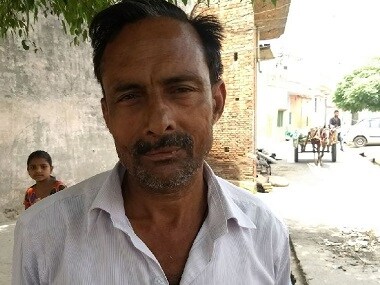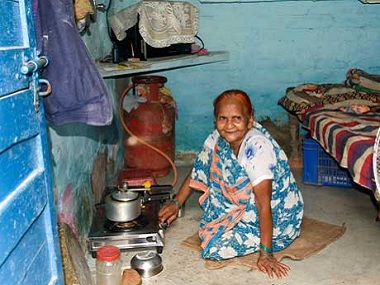Editor’s note: Over two years have passed since the inauguration of the Pradhan Mantri Ujjwala Yojana in the district of Ballia in Uttar Pradesh. The scheme, which aims to provide LPG connections to economically weaker sections, has often been cited by Prime Minister Narendra Modi to showcase the Centre’s work towards poverty alleviation. In this series of reports, Firstpost seeks to assess the impact of the scheme on the ground in western Uttar Pradesh. Mukesh Jain, a resident of Sonta village in Uttar Pradesh’s Muzaffarnagar district, says that the mindset of expecting the government to offer lifestyle-altering services absolutely free of cost is deep-rooted among the people of India. When asked about the Pradhan Mantri Ujjwala Yojana (PMUY), under which LPG (liquefied petroleum gas) connections are offered to people below the poverty line, he says that the first problem is that people are expected to pay Rs 1,500 for one connection. Firstpost hit ground zero to assess the implementation challenges of this programme, that was launched by Prime Minister Narendra Modi on 1 May, 2016, in Ballia. First and foremost, the cost for each LPG connection is between Rs 3,100-Rs 3,200. Initially, under this scheme, per family indemnity of Rs 1,600 was being offered and families were paying Rs 1,500 for an LPG stove and gas cylinder. Jain explains that many people in Muzaffarnagar district misinterpreted the scheme and thought that it meant that the government is going to hand out free connections. [caption id=“attachment_4482437” align=“alignleft” width=“380”] Representational image. Firstpost/Naresh Sharma[/caption] Gradually, they began feeling that the Rs 1,500 they were made to pay were filling the pockets of private gas companies that gave rise to speculations regarding corruption by government officials. The misinformation regarding the Ujjwala scheme is evident from the way people speak about the scheme in western Uttar Pradesh. However, the government has devised a way to deal with this situation at the grassroots level. To those who were unable to pay the Rs 1500 fee, gas companies started offering interest-free loans. The beneficiaries were granted Rs 1,500 to avail the benefits of the Ujjwala scheme and easy instalments were fixed. Gas companies found their own way to recover these interest-free loans. The government subsidy on gas was converted into a loan instalment and until the loan amount of Rs 1,500 was completed, the subsidy was not stopped. So, if someone takes a loan of Rs 1,500 from the gas company for the LPG connection under the Ujjwala scheme, then the repayment of the loan will be effected through deductions from the gas subsidy provided by the government. If a subsidy of Rs 200 is given on a gas cylinder of Rs 715, then the consumer availing the loan will have to pay the company Rs 715 for the gas cylinder. An amount of Rs 200 will be deducted from the consumer loan. So, after a deduction of Rs 200 from a loan of Rs 1500, the repayment amount will be Rs 1,300. In this way, consumers who opt for the loan will not get the subsidy till the full loan of Rs 1,500 is paid. The beneficiary of a loan under the scheme receives the amount of government subsidy after taking seven-eight gas cylinders. This plan comes across as a good option initially because of not having to pay a single penny while taking the LPG connection but, as soon as the consumers realise they’re not receiving any subsidy on the gas cylinder, they become careless about taking the next cylinder. This is a common sentiment in Muzaffarnagar, where poor villagers complain that they can’t afford expensive cylinders without subsidy. Another hurdle in the successful implementation of the scheme is that a section of villagers doesn’t consider LPG as primary cooking fuel. To make food in the villages, wood and dung extract is still considered cheap and effective. These are age-old practices and mindsets take a long to change. Under the Ujjwala scheme, consumers in Muzaffarnagar who receive the facility of LPG gas connections also think that wood and cow-dung cakes should be used up before the gas stove is lit. Also, the assumption that they don’t have to separately spend on wood and cow-dung the way they have to on a gas cylinder keeps them wary of the idea which in the long run will prove beneficial to them. [caption id=“attachment_4482469” align=“alignright” width=“380”]
 Mukesh Jain, a resident of Sonta village in Uttar Pradesh’s Muzaffarnagar district. Firstpost Hindi[/caption] For instance, Sunita from Sonta village hasn’t started using the LPG connection that was given to her months ago. Jain explains that cow-dung cakes are readily available and says this explains the abysmal usage of LPG available to villagers like Sunita. He also talks about how one cylinder lasts up to a year in some homes. Here, many women like Sunita ask what they should do with cow-dung cakes lying around the house all the time. Hence, LPG cylinders are used on special occasions or during some kind of emergency or when it’s entirely too hot to burn wood. According to the 2011 Census, 85 percent of rural households use biomass, coal or kerosene as cooking fuel. Whereas in the cities it is used in 25 percent households. Also, 60 percent of the total LPG users use it as the primary cooking fuel. These figures from 2011 have not changed much. This figure can be understood from the fact that there are many consumers who can afford the use of LPG, but still, do not use it as the primary cooking fuel. The ground reality at Muzaffarnagar corresponds with the findings of a
Crisil report on the transition from biomass to LPG cylinders, where 85 percent of the respondents who hadn’t adopted the technology cited expense as the prime reason. Among the surveyed states, the perception of LPG being unsafe is 46 percent. In states like Gujarat, Jharkhand, Odisha, Rajasthan and Uttar Pradesh, 50 percent or more households mentioned safety as a barrier. Low awareness with regard to advantages of LPG as a cooking fuel has been cited as a spanner towards the adoption of LPG. The report states that non-familiarity about operating an LPG stove is a concern expressed by 35 percent of the surveyed households. The scheme may have reached the poorest of homes in western Uttar Pradesh in a district like Muzaffarnagar where communal and caste violence is common, but despite the government’s efforts, the awareness regarding their own health and well-being still waits at a sorry distance. Read Part 1:
Dalits in western UP laud benefits despite resentment against Centre on other issues
Mukesh Jain, a resident of Sonta village in Uttar Pradesh’s Muzaffarnagar district. Firstpost Hindi[/caption] For instance, Sunita from Sonta village hasn’t started using the LPG connection that was given to her months ago. Jain explains that cow-dung cakes are readily available and says this explains the abysmal usage of LPG available to villagers like Sunita. He also talks about how one cylinder lasts up to a year in some homes. Here, many women like Sunita ask what they should do with cow-dung cakes lying around the house all the time. Hence, LPG cylinders are used on special occasions or during some kind of emergency or when it’s entirely too hot to burn wood. According to the 2011 Census, 85 percent of rural households use biomass, coal or kerosene as cooking fuel. Whereas in the cities it is used in 25 percent households. Also, 60 percent of the total LPG users use it as the primary cooking fuel. These figures from 2011 have not changed much. This figure can be understood from the fact that there are many consumers who can afford the use of LPG, but still, do not use it as the primary cooking fuel. The ground reality at Muzaffarnagar corresponds with the findings of a
Crisil report on the transition from biomass to LPG cylinders, where 85 percent of the respondents who hadn’t adopted the technology cited expense as the prime reason. Among the surveyed states, the perception of LPG being unsafe is 46 percent. In states like Gujarat, Jharkhand, Odisha, Rajasthan and Uttar Pradesh, 50 percent or more households mentioned safety as a barrier. Low awareness with regard to advantages of LPG as a cooking fuel has been cited as a spanner towards the adoption of LPG. The report states that non-familiarity about operating an LPG stove is a concern expressed by 35 percent of the surveyed households. The scheme may have reached the poorest of homes in western Uttar Pradesh in a district like Muzaffarnagar where communal and caste violence is common, but despite the government’s efforts, the awareness regarding their own health and well-being still waits at a sorry distance. Read Part 1:
Dalits in western UP laud benefits despite resentment against Centre on other issues
Despite the government’s efforts to implement the Ujjwala Yojana, awareness regarding LPG and its health and other benefits is still in a sorry state.
Advertisement
End of Article


)

)
)
)
)
)
)
)
)



